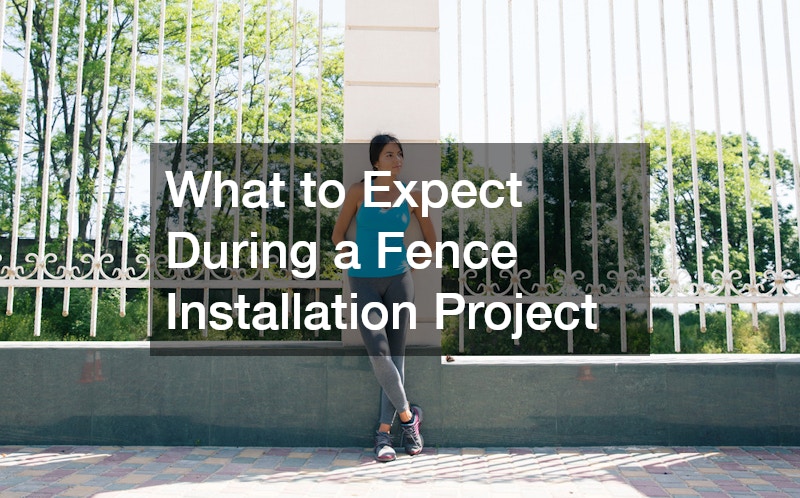Understanding what to expect during a fence installation project can help homeowners feel more prepared and confident when undertaking this outdoor home improvement project. This article will address common questions and topics related to the timeline, costs, and maintenance associated with fence installations. By breaking down important factors and offering practical advice, homeowners can make informed decisions and enjoy the process of enhancing their property with a new fence.
The Length of a Fence Installation Project
Factors Influencing Installation Time
Several factors influence the duration of a fence installation project, which can vary significantly based on individual circumstances. The size of the property and the length of the fence needed are primary considerations, as larger projects naturally require more time.
Additionally, the terrain plays a crucial role; uneven or rocky ground demands more preparation and effort, potentially extending the timeline.
Weather conditions are another key factor that can’t be overlooked. Inclement weather, such as rain or excessive heat, can delay the installation process, as certain materials require dry conditions for installation. Choosing the right time of year for your project by considering local weather patterns can help avoid unnecessary delays.
The choice of materials also impacts how long the installation will take. Some materials, like vinyl, might be quicker to install compared to traditional wood, which requires more precise handling and finishing. Furthermore, if custom designs or additional decorative elements are desired, these can prolong the installation time due to their complexity.
Average Timelines for Different Fence Types
The type of fence material chosen has a substantial effect on the project timeline. On average, a wooden fence installation might take anywhere from two to five days, considering its need for careful assembly and treatment. In contrast, a vinyl fence can often be completed within a day or two, thanks to its prefabricated panels that are quicker to set in place.
Metal fences such as wrought iron or aluminum, known for their durability, tend to have variable timelines depending on the required customization and design intricacies; these projects can last from three to seven days. Chain-link fences, appreciated for their simplicity and cost-effectiveness, usually take about two to three days to install. Each type of fence brings unique characteristics to a property, influencing both the timeframe and the overall aesthetic result.
It’s important for homeowners to communicate with their contractors regarding expected timelines based on the material and design choices. Knowing average installation times helps set realistic expectations and allows for efficient planning around the installation. This prepared approach minimizes disruptions to daily life and ensures the project is completed to satisfaction.
Costs Involved in a Fence Installation Project
Initial Expenses and Budgeting
When embarking on a fence installation project, understanding the initial expenses is crucial for homeowners aiming to manage their budget effectively. Material costs vary widely, with wood and chain-link being more affordable options, whereas metal and vinyl may demand a higher investment. Beyond materials, labor costs can constitute a significant portion of the expense, particularly for intricate designs or challenging terrains.
Additionally, permits may be required by local authorities, adding to the overall cost; this is an essential step to ensure compliance with zoning laws and property regulations. Homeowners should also consider potential expenses for accessories like gates or custom decor, which elevate both the functionality and aesthetics of the fence. Creating a comprehensive budget plan that includes all these aspects allows for a clearer financial picture and reduces unexpected costs.
Long-Term Investment and Value
Beyond immediate expenses, fences serve as a long-term investment with potential value additions to the property. A well-constructed fence offers increased privacy and security, enhancing the overall appeal and utility of the home. Furthermore, a quality fence can boost the property’s curb appeal, potentially increasing its market value and attractiveness to future buyers.
Different materials offer varied life expectancies and advantages. For instance, while wood fences require ongoing maintenance but offer natural beauty, vinyl and metal options might present higher durability with less upkeep. Evaluating these factors allows homeowners to align their choice with long-term goals, optimizing both enjoyment and financial return on investment.
How Homeowners Should Prepare for a Fence Installation
Site Preparation and Planning
Effective site preparation is crucial to streamline the fence installation process and prevent complications. Homeowners should start by clearing the designated area of debris, vegetation, and obstacles, providing a clean slate for installation. Marking property boundaries accurately is essential to avoid disputes with neighbors and ensure the fence complies with local regulations.
Open communication with neighbors is advisable when planning a fence installation, especially if the structure borders their property. Discussing plans can prevent misunderstandings, foster goodwill, and even lead to possible collaborations on shared fence expenses. Understanding and adhering to community guidelines and zoning laws also avert potential legal issues.
Post-Installation Care and Maintenance
Post-installation care plays a critical role in extending the lifespan and maintaining the appearance of a newly installed fence. Regular cleaning is recommended to prevent the buildup of dirt, mold, or mildew, particularly on materials like wood or vinyl. Depending on the material, periodic treatments such as staining, painting, or applying a sealant may be necessary to protect against weather elements.
Inspecting the fence regularly for damage or wear enables timely repairs, preventing minor issues from escalating into costly replacements. Homeowners should pay close attention to hardware and fixings, ensuring they remain secure and free from rust or deterioration. By prioritizing maintenance, the functional and aesthetic benefits of the fence can be preserved over time.
Installing a fence is a significant project that requires careful planning and consideration. By understanding the timelines, financial implications, and preparatory steps involved, homeowners can better navigate the installation process and enjoy the functional and aesthetic benefits of their new fence. With the insights provided in this article, you are well-equipped to manage your fence installation with confidence and achieve a successful outcome for your property enhancements.

